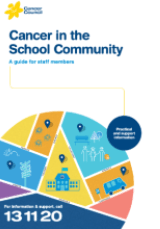- Home
- About Cancer
- Schools and teachers
- Cancer in the school community
- Talking about cancer in schools
Talking about cancer in schools
Talking about cancer is never easy, and you may feel concerned about saying the wrong thing. It can also be challenging to balance a person’s right to privacy with the need for others to know about their diagnosis. Use your school’s existing well-being and communication guidelines and resources as you provide support.
Learn more about:
- Who gets cancer?
- Talking to someone with cancer
- Respecting privacy
- Appointing a school liaison person
- Understanding differences
- Communicating with people of all ages
- Different views of cancer
Who gets cancer?
An estimated one in two Australians will be diagnosed with cancer by the age of 85. In Australia, more than 127,000 people are diagnosed with cancer every year. People over the age of 50 are the most likely to be diagnosed with cancer, and children are the least likely. Unfortunately, however, some children and young people are diagnosed with cancer.
In adult men, the most common forms of cancer are prostate cancer, bowel cancer, melanoma, and lung cancer. Adult women are most often diagnosed with breast cancer, bowel cancer, melanoma, and lung cancer.
Cancer in children and adolescents
In Australia, about 1000 children aged 0–19 develop cancer every year, which means that at any time there are thousands of school students who have had cancer. Advances in diagnosis, treatment and follow-up care mean the overall five-year survival rate for children and adolescents is now more than 80%. This can vary depending on the age of the patient and their cancer type.
Cancers affecting children generally differ from those affecting adults. Childhood cancers commonly occur in different parts of the body and are not usually linked to lifestyle or environmental factors. They tend to be more responsive to chemotherapy, and children often tolerate the treatments better.
Some side effects from treatment may not show up until many months or years later. These are called late effects. This is particularly the case for a child who was treated at a young age. Any student who has survived cancer will need appropriate support for the rest of their school years.
Childhood cancers
The most common types of childhood cancer in Australia are:
- leukaemia – a cancer that affects the blood cells; the two main types are acute lymphoblastic leukaemia and acute myeloid leukaemia
- brain tumours – the most common types in children are gliomas (starting in the brain’s glial cells) and medulloblastoma (starting in the cerebellum, the lower back part of the brain)
- lymphoma – a cancer that develops in the lymphatic system; the two main types are Hodgkin lymphoma and non-Hodgkin lymphoma
- neuroblastoma – a cancer of the nerve cells involved in the development of the nervous system
- sarcoma – a malignant tumour that develops in the bone, muscle or connective tissue.
→ READ MORE: Talking to someone with cancer
Podcast: Explaining Cancer to Kids
Listen to more episodes from our podcast for people affected by cancer
More resources
Claire Tobin, Principal Medical Advisor, Department of Education and Training, VIC; Dr Antoinette Anazodo, Paediatric and Adolescent Oncologist, Sydney Children’s Hospital and Prince of Wales Hospital, Director of The Sydney Youth Cancer Service, and Conjoint Senior Researcher, University of New South Wales, NSW; Lisa Barrow, Clinical Nurse Educator, Children’s Cancer Centre, Royal Children’s Hospital, Melbourne, VIC; Margo Bulic, Psychosocial Support Worker, CanTeen, ACT; Amber Copeland, 13 11 20 Consultant, Cancer Council Queensland; Donna Drew, Clinical Nurse Consultant, Paediatric Oncology/Palliative Care, Kids Cancer Centre, Sydney Children’s Hospital, Randwick, NSW; Allesha Fecondo, Education Consultant, Victorian Paediatric Rehabilitation Service, and Education Liaison, Ronald McDonald Learning Program, Ronald McDonald House Charities Australia, VIC; John Friedsam, General Manager of Divisions, CanTeen Australia, NSW; Pina Hutcheson, President, Catholic Primary Principals’ Association of WA; Cara Irvine, Year 8 Coordinator, Alfred Deakin High School, ACT; Andrew Long, Assistant Director, Policy and Research, Independent Schools Council of Australia, ACT; Dr Alistair Lum, Post-doctoral Research Fellow – Behavioural Sciences Unit, Sydney Children’s Hospital, University of New South Wales, NSW; Kristine Luszczynski, Learning Program Manager, Quality and Standards, Ronald McDonald House Charities Australia, NSW; Anita Neville, National Manager, Ronald McDonald Learning Program, Ronald McDonald House Charities Australia, VIC; NSW Department of Education, NSW; Mandy Roney, Consumer; Shannon Rush, Primary School Program Manager, Camp Quality, SA; Luke Wade, Education and Career Support Consultant, Redkite, QLD.
View the Cancer Council NSW editorial policy.
View all publications or call 13 11 20 for free printed copies.
Need to talk?
Support services
Coping with cancer?
Speak to a health professional or to someone who has been there, or find a support group or forum
Looking for transport, accommodation or home help?
Practical advice and support during and after treatment
Cancer information
What is cancer?
How cancer starts and spreads
Dealing with the diagnosis
Common reactions to a cancer diagnosis and how to find hope


